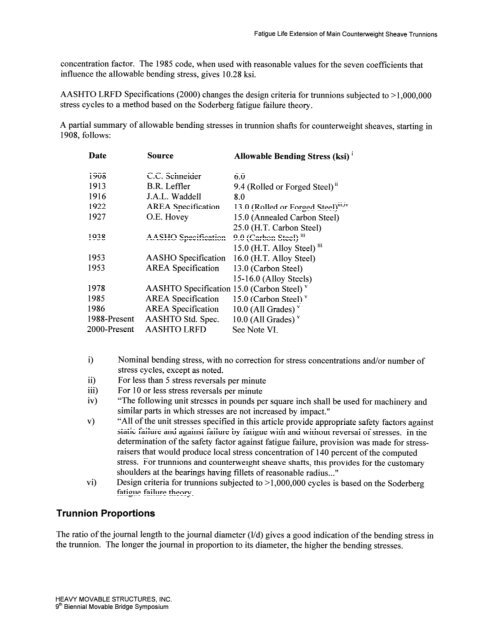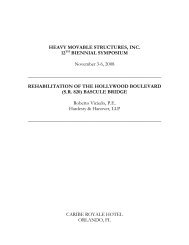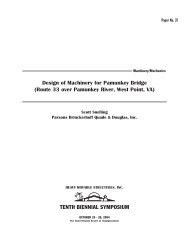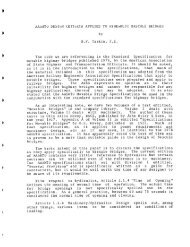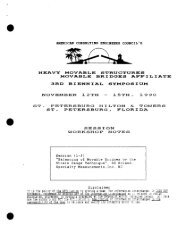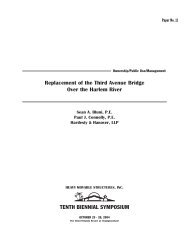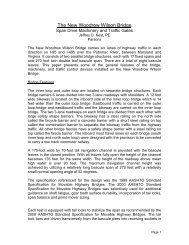Fatigue of Counterweight Sheave Trunnions - Heavy Movable ...
Fatigue of Counterweight Sheave Trunnions - Heavy Movable ...
Fatigue of Counterweight Sheave Trunnions - Heavy Movable ...
You also want an ePaper? Increase the reach of your titles
YUMPU automatically turns print PDFs into web optimized ePapers that Google loves.
<strong>Fatigue</strong> Life Extension <strong>of</strong> Main <strong>Counterweight</strong> <strong>Sheave</strong> <strong>Trunnions</strong><br />
concentration factor. The 1985 code, when used with reasonable values for the seven coefficients that<br />
influence the allowable bending stress, gives 10.28 ksi.<br />
AASHTO LRFD Specifications (2000) changes the design criteria for trunnions subjected to >1,000,000<br />
stress cycles to a method based on the Soderberg fatigue failure theory.<br />
A partial summary <strong>of</strong> allowable bending stresses in trunnion shafts for counterweight sheaves, starting in<br />
1908, follows:<br />
Date Source Allowable Bending Stress (hi) '<br />
C.C. Schneider 6.0<br />
B.R. Leffler 9.4 (Rolled or Forged Steel) "<br />
J.A.L. Waddell 8.0<br />
AREA Specification 13.0 (Rolled or Forged Steel)"'*'v<br />
O.E. Hovey 15.0 (Annealed Carbon Steel)<br />
25.0 (H.T. Carbon Steel)<br />
AASHO Specification 9.0 (Carbon Steel) "'<br />
15.0 (H.T. Alloy Steel) 'I'<br />
AASHO Specification 16.0 (H.T. Alloy Steel)<br />
AREA Specification 13.0 (Carbon Steel)<br />
15-16.0 (Alloy Steels)<br />
AASHTO Specification 15.0 (Carbon Steel) "<br />
AREA Specification 15.0 (Carbon Steel) "<br />
AREA Specification 10.0 (All Grades) "<br />
AASHTO Std. Spec. 10.0 (All Grades) '<br />
AASHTO LRFD See Note VI.<br />
i) Nominal bending stress, with no correction for stress concentrations and/or number <strong>of</strong><br />
stress cycles, except as noted.<br />
ii) For less than 5 stress reversals per minute<br />
iii) For 10 or less stress reversals per minutc<br />
iv) "The following unit stresses in pounds per square inch shall be used for machinery and<br />
similar parts in which stresses are not increased by impact."<br />
v) "All <strong>of</strong> the unit stresses specified in this article provide appropriate safety factors against<br />
static failure and against failure by fatigue with and without reversal <strong>of</strong> stresses. In the<br />
determination <strong>of</strong> the safety factor against fatigue failure, provision was made for stressraisers<br />
that would produce local stress concentration <strong>of</strong> 140 percent <strong>of</strong> the computed<br />
stress. For trunnions and counterweight sheave shafts, this provides for the customary<br />
shoulders at the bearings having fillets <strong>of</strong> reasonable radius ..."<br />
vi) Design criteria for trunnions subjected to >1,000,000 cycles is based on the Soderberg<br />
fatigue failure theory.<br />
Trunnion Proportions<br />
The ratio <strong>of</strong> the journal length to the journal diameter (1/d) gives a good indication <strong>of</strong> the bending stress in<br />
the trunnion. The longer the journal in proportion to its diameter, the higher the bending stresses.<br />
HEAVY MOVABLE STRUCTURES, INC<br />
gth Biennial <strong>Movable</strong> Bridge Symposium


